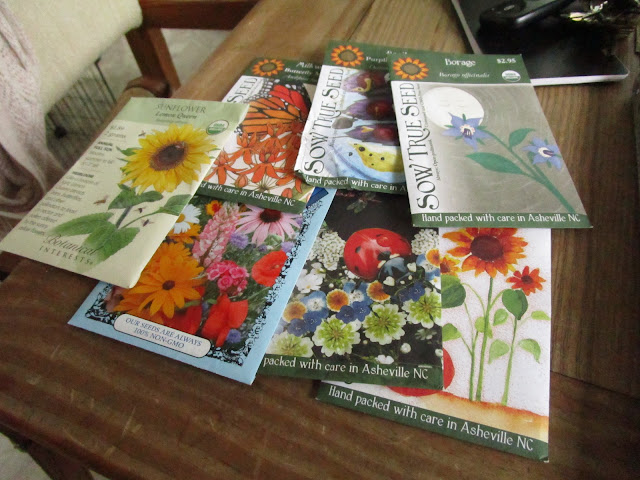Reaping What You Sow Part Three: Reading a Seed Packet
Reading a seed packet
Hi All,Things are really starting to thaw here, which is great because after just one day inside I was definitely starting to get some cabin fever.
Our last post was talking about some terms you might see on a seed packet. Today, we are going to take that knowledge and apply it as well as a few new things.
So, let's get right down to it and analyze two seed packets
Packet 1: Butterfly Flower Mix
The front of the packet gave some good general information like it's name, a pretty picture, the fact it is an annual, how tall it will grow, how many grams of seed it contains as well as price. Good stuff, but we want to focus more on the backIn order to get a good view of this packet, I ended up cutting off some of the top. It has information as far was when to sow, how much to sow, and some general tips like seed spacing, etc. Below that, it has a chart.
Days to Germination - the amount of time it will take for the seed to germinate (i.e. sprout into a seedling) at the ideal soil temperature range for that seed.
Days to Bloom (or harvest) - this is the amount of time it will take from when it is planted or when it pops up to be in bloom or if it were an edible plant it might be its harvest date.
Plant Height - this is how tall the plant will be. When making an attractive flower bed things like height and width make a big difference in the overall appearance of the flower bed.
Plant Spacing - this is how far apart the seeds should be spread. In this case, since we are dealing with a wild flower type mix they do just fine scattered around. Other plants like onions or cabbages need specific spacing and then need to be thinned after they are planted.
Grows Best - the amount of sunlight or soil conditions in which they do the best. This one is flexible and does well in sunlight or maybe even a slightly shady spot of the yard that still gets a good bit of sun.
Map - the little map on the corner shows different growing regions known as zones. There are more than four but this packet was probably developed for the south east so it doesn't show the zones in the North West of the United States. With that in mind, this makes it easy to look at the packet and see what time to plant it. That map isn't necessary because a lot of seed catalogs or garden supplies will have charts that show planting times for their particular region but it sure it nice to have. I sort my seeds by what time of year they need to be planted.
Every company has a seed packet that looks a little different. Let's check this next one out here.
Packet 2: Dr. Wyche's Tomato
Organic, Open-Pollinated & Untreated - we know from the previous post what those terms mean. Notice that packet 1 didn't indicate any of that. That doesn't mean that is not true about packet 1 but it does not mean that it is.
Scientific Name - solanum lycopersicum is the scientific name for a tomato. This is important for people who are saving their seeds because if they want their saved tomatoes seeds to grow "true" then they need to avoid cross pollination with plants of the same species and genus.
Indeterminate V. Determinate - a brief explanation is that indeterminate tomatoes are those that are more vine like and will continue to produce throughout their growing season until they are killed by frost. Determinate crops grow all their tomatoes all at once, they all ripen at the same time, and then the plant dies. Both require slightly different care to get the most yield from the plants. For way more info click here.
Now on to the chart!
We are familiar with many of these terms already but let's highlight some we didn't see before.
Seed depth - this is how deep a seed must be sown. Too deep and the sunlight won't be able to warm it up. Not deep enough and it could be blow away. Packet 1 didn't have a seed depth because wildflower seeds are made to just be scattered around anyway.
Sprout - same thing as germinate
Mature spacing - I mentioned this briefly earlier but this is how much space a full grown plant will need. Once again, this is important when planning a garden to make sure that each plant will have enough room to grow to its fullest potential more or less.
Approximate Seeds - this tells you the number of seeds in each packet. This will vary by how much each seed weighs and other factors.
Notice this packet didn't tell you when to plant. That's okay because their catalog came with a huge chart of growing times. Even so, I always recommend getting a chart of your region from your extension office.
Seed packets contain a lot of valuable information. It is up to us to be informed and make good choices for us about what to buy and went to plant. Hopefully this will help you as you make your gardening choices.
For more information check out my other posts in the series, Reaping What You Sow.
Part 1: Seed and Plant Selection
Part 2: What Does it All Mean
Part 4: ????
Take care,
Rebecca




Comments
Post a Comment